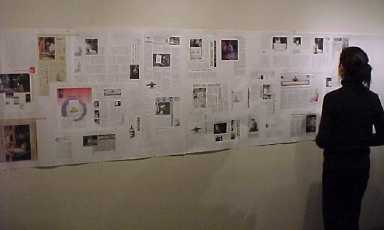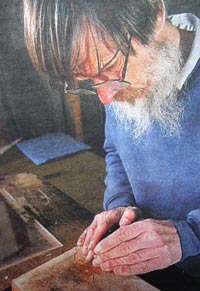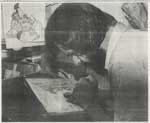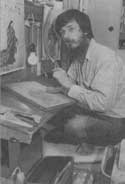Woodblock Shimbun - Introduction
The media here in Japan have been very good to me over the years. Especially during the time that I was working on the Hyakunin Isshu project, newspapers, magazines, radio and television almost never failed to respond to my requests to help me publicize my exhibitions.

I'm certainly not 'famous' here, and can walk down the street without attracting attention, but during the few days immediately following a television appearance, do find that I get recognized in the train sometimes. Generally though, people are considerate of one's privacy, and unlike the really famous foreigners here (sumo wrestlers, etc.) I live generally undisturbed.
Reading/viewing some of this material is an excellent way to get familiar with my work, so I have scanned/ripped/typed many of the items, and included them here in my 'Woodblock Shimbun'. You will find a 'Table of Contents' over on the Index Page. Please take a look at some of the material; I think you might enjoy it!
Thank you!
TV Listings
The 'Woodblock Shimbun' has a full selection of TV programs on file. Videos available include some of David's news appearances, complete feature programs, and some short documentaries on his work. The files are in QuickTime format, and can be easily viewed with your browser.
Program listings are on the Index page ... ![]()
David Bull, Woodblock Printmaker
When I arrive at David Bull's home in Ome in Tokyo's western suburb on a cold but sunny morning in late March, he is checking a huge delivery of kiri wood boxes from China. But this time he is not quite satisfied ... (2007)
Full Story. ![]()
Recapturing Edo Images
Squatting in front of a photocopy of an ukiyo-e print in the light from a 50-watt bulb, David Bull puts his carving knife carefully to a block of cherry wood. Under his blade, the image of an elaborately robed Heian minister slowly begins to emerge. "The hardest thing about making woodblock prints is the carving of intricate lines - you have to be able to use your knife like a brush in order to do justice to the fine lines," Bull says. (1989)
Full Story. ![]()
Carving a Career From an Ancient Japanese Craft
David Bull, a 41-year-old Canadian university
dropout born in England who used to program computers and play the
flute on the street, anticipates one day finding himself revered as a
master practicioner of an ancient Japanese craft. But it took him 35
years to hit upon that uncommon ambition. (1993)
Full Story. ![]()




